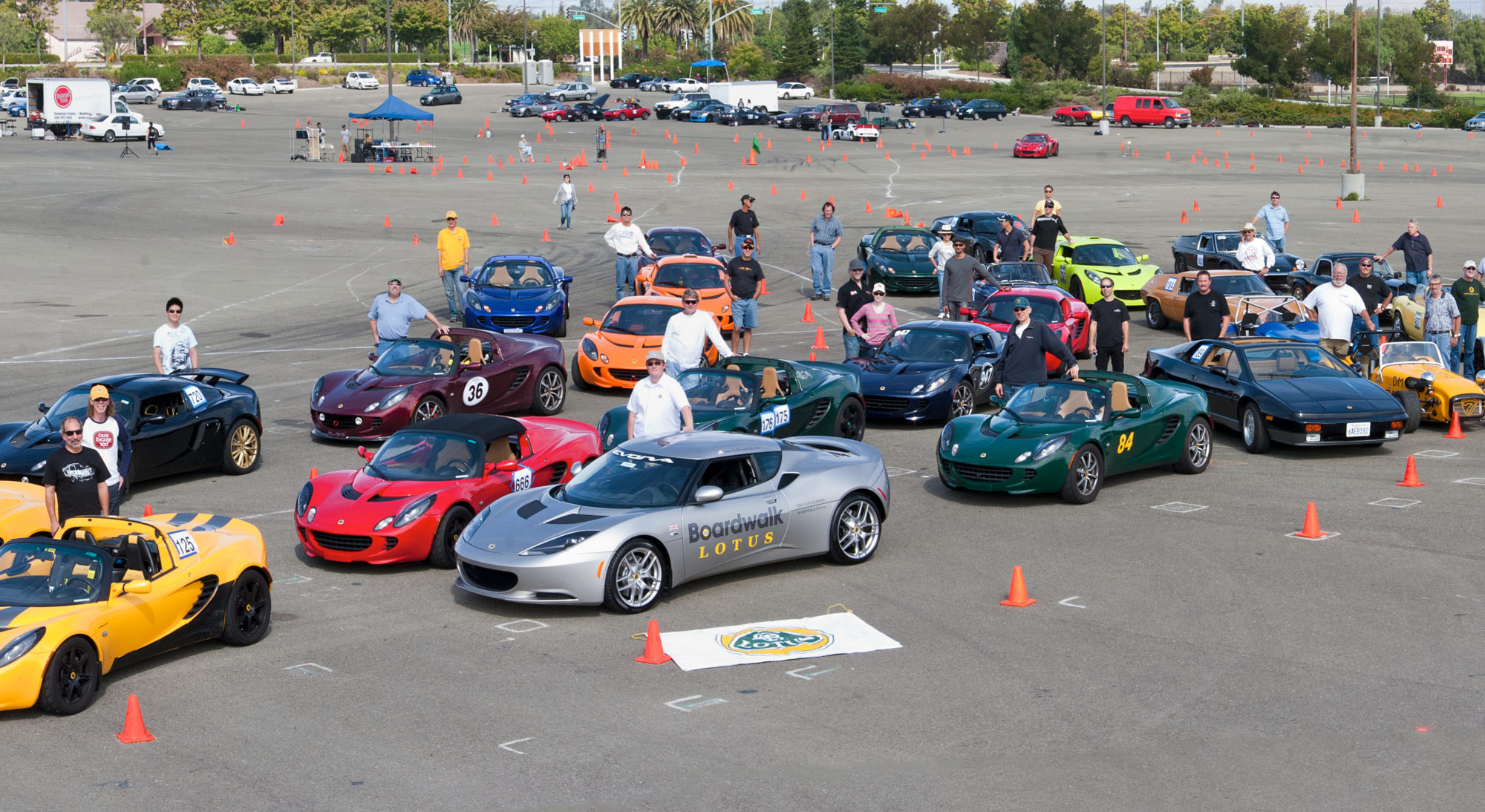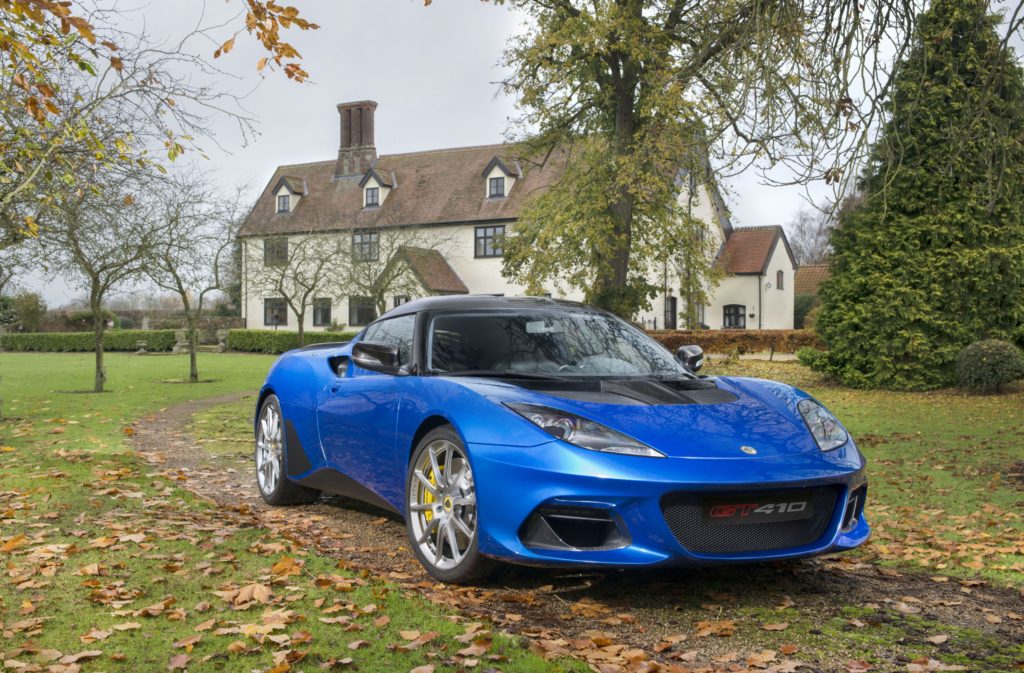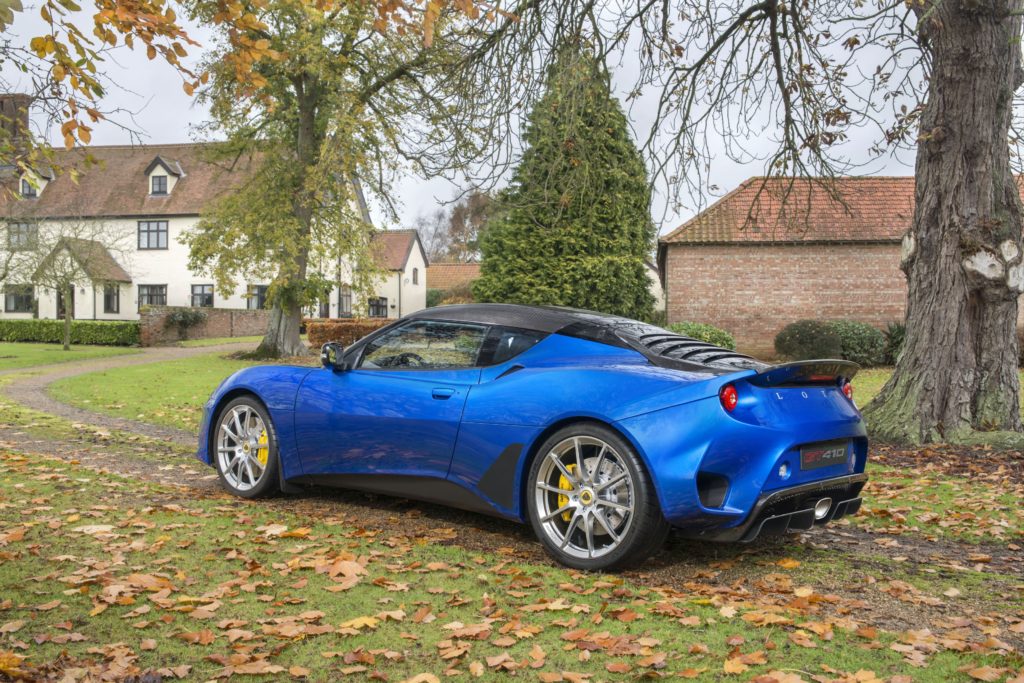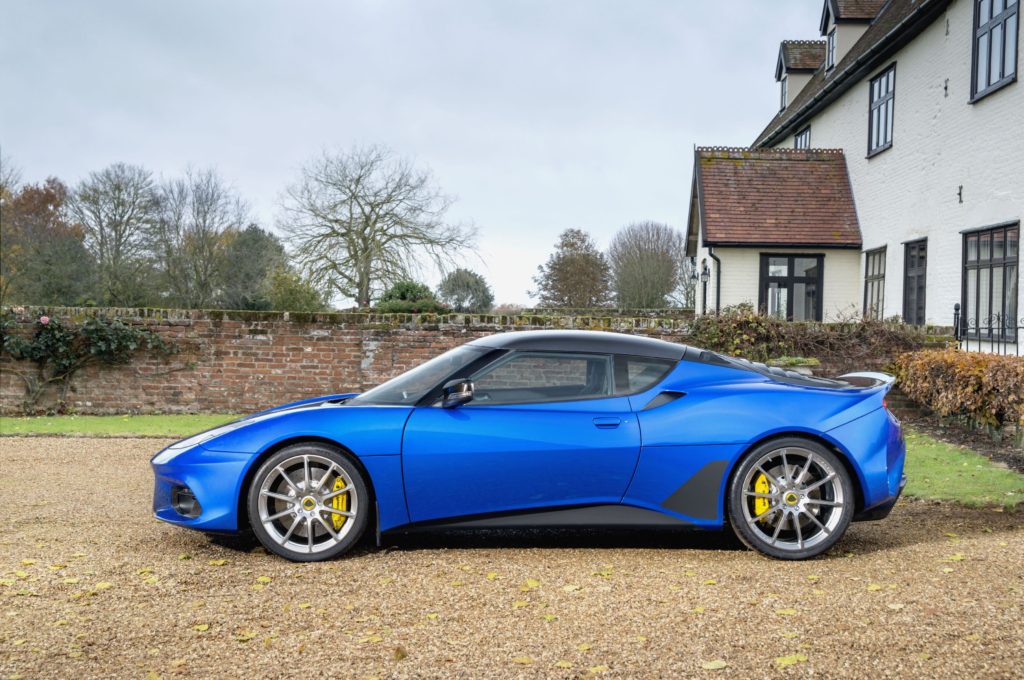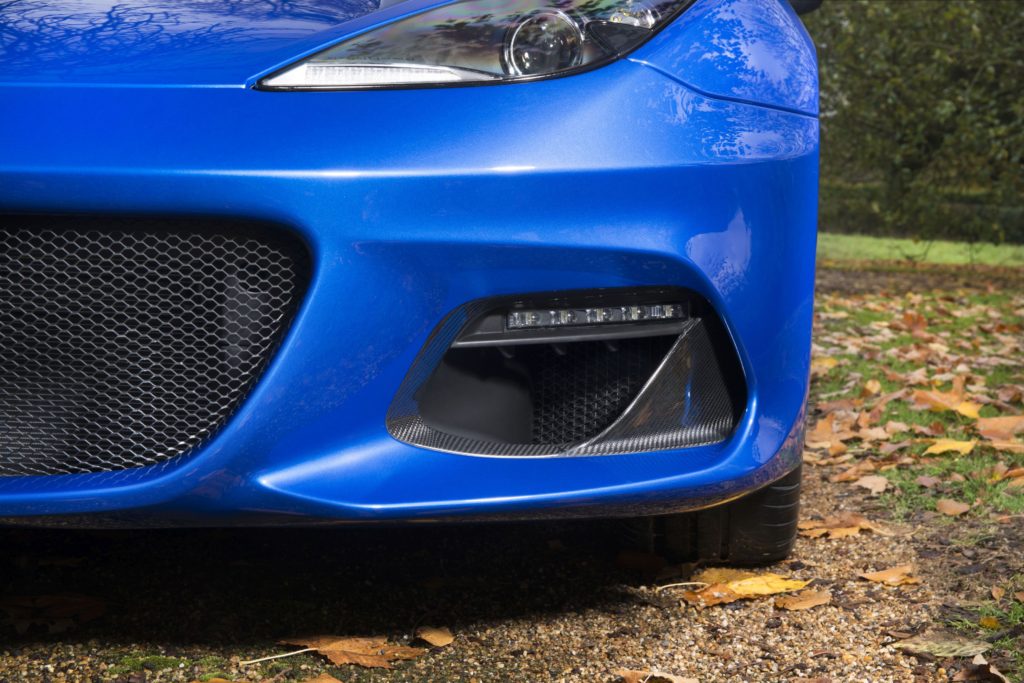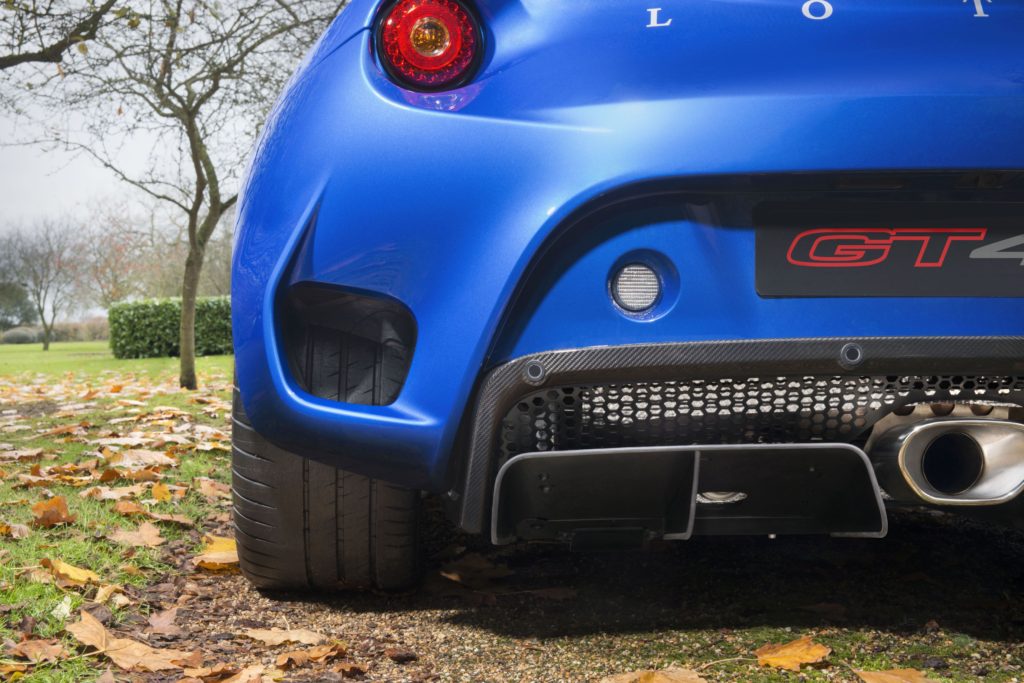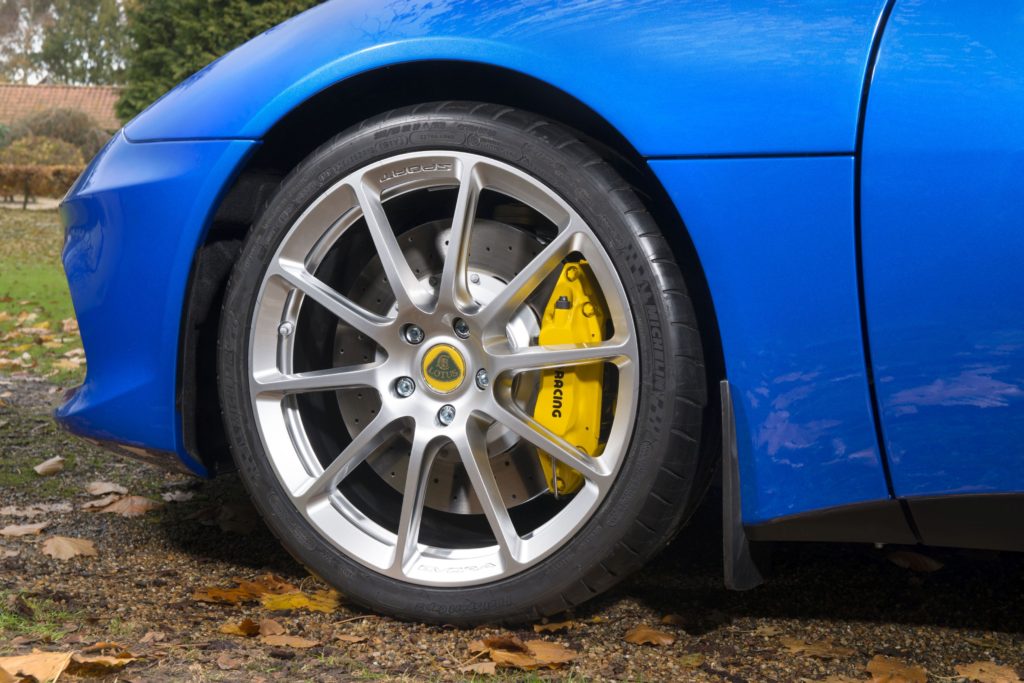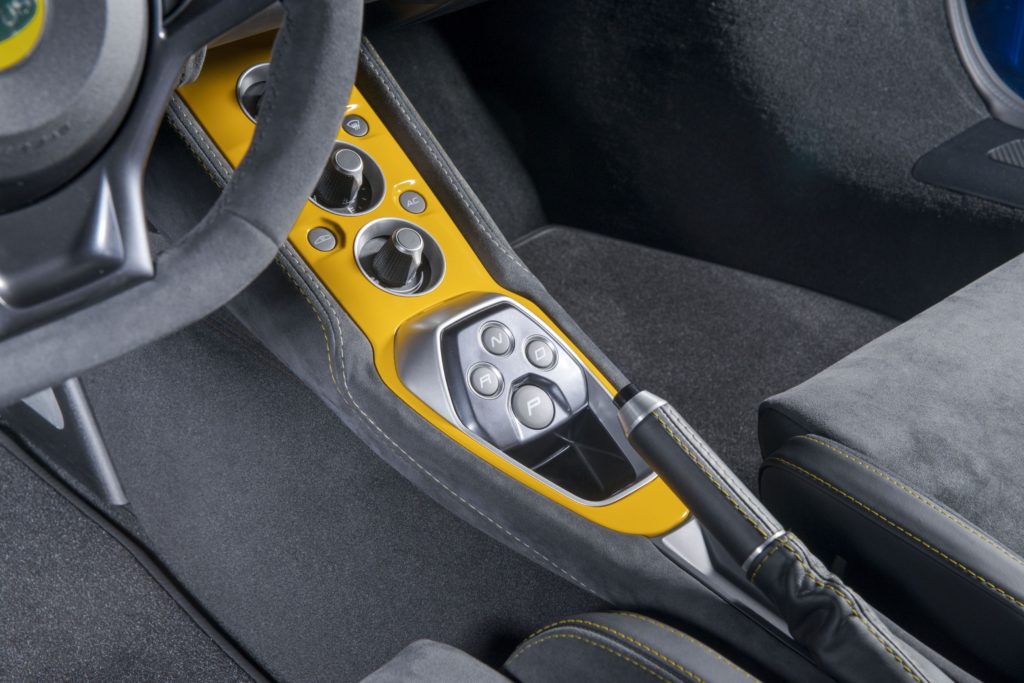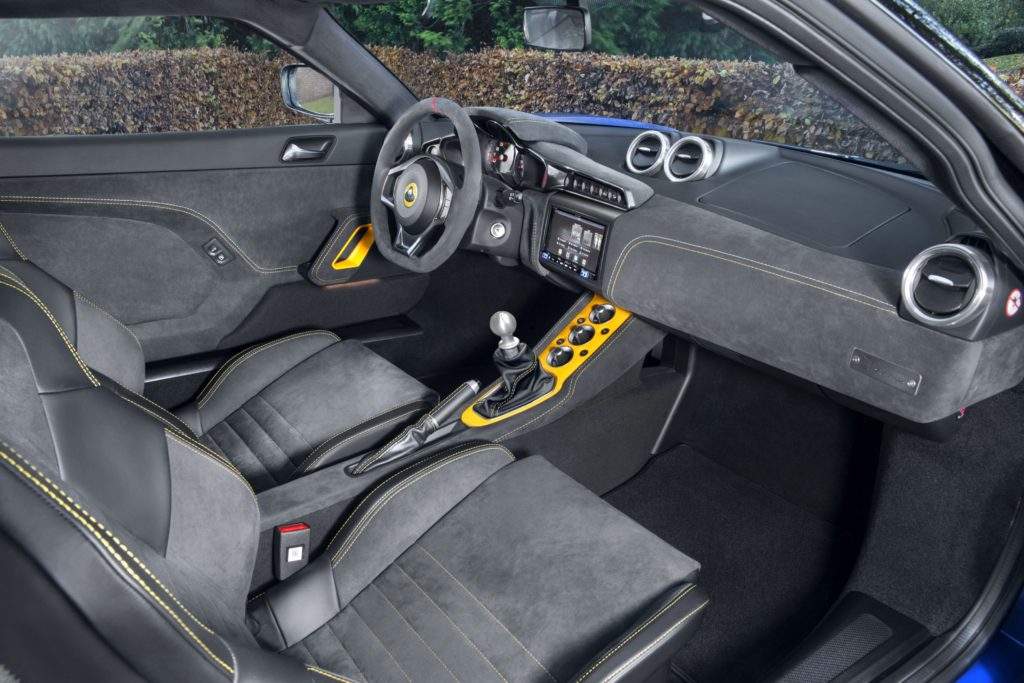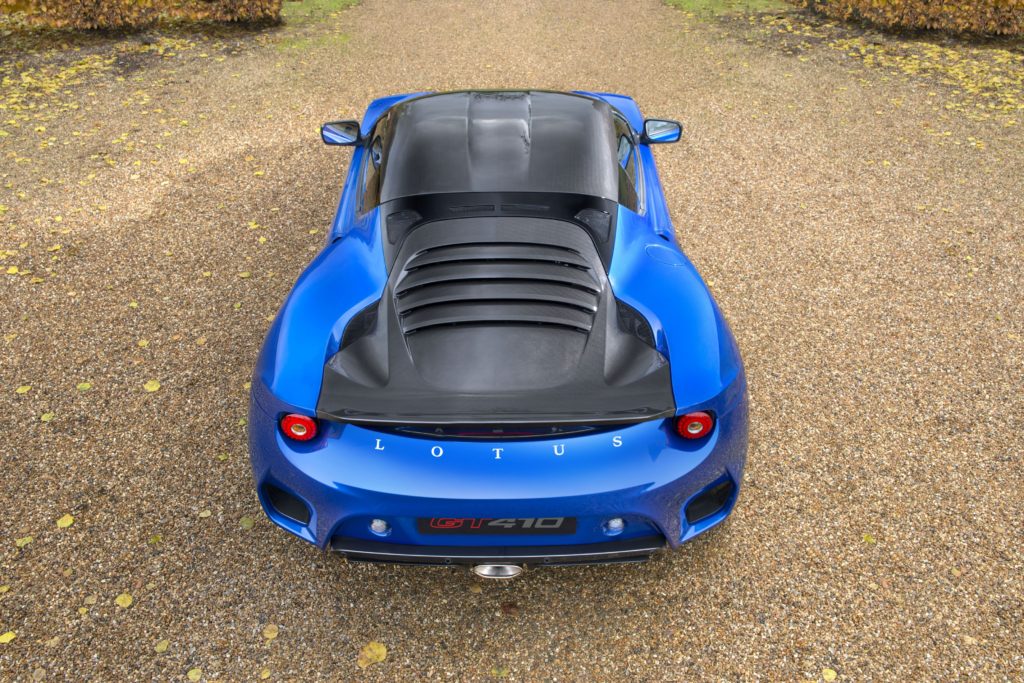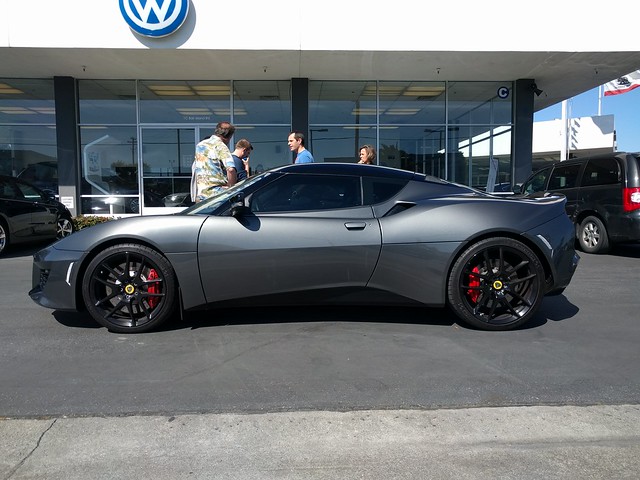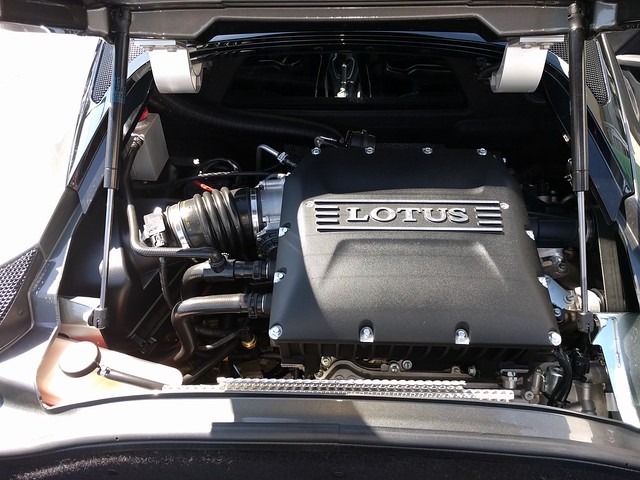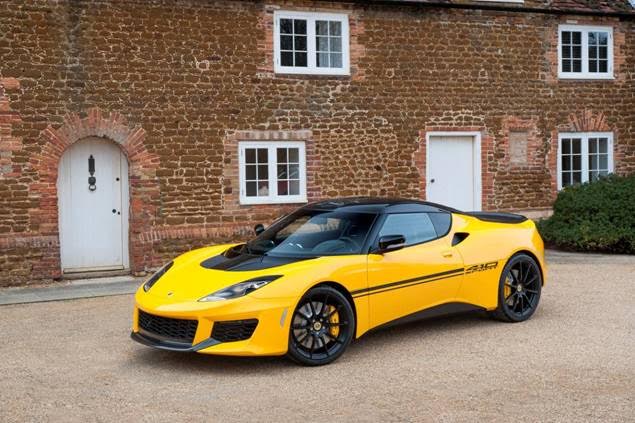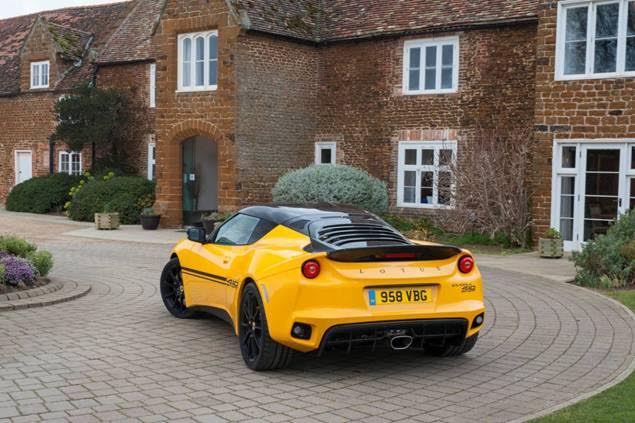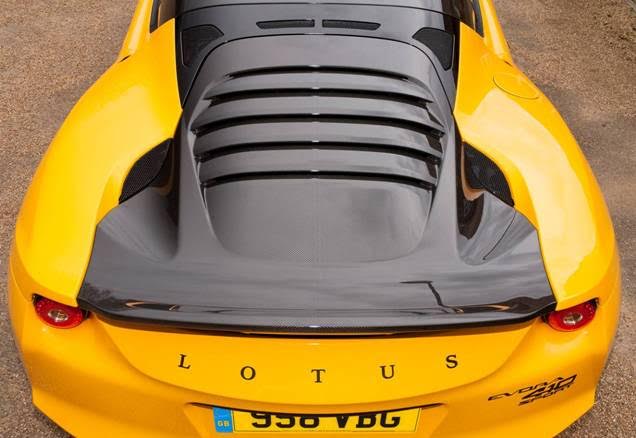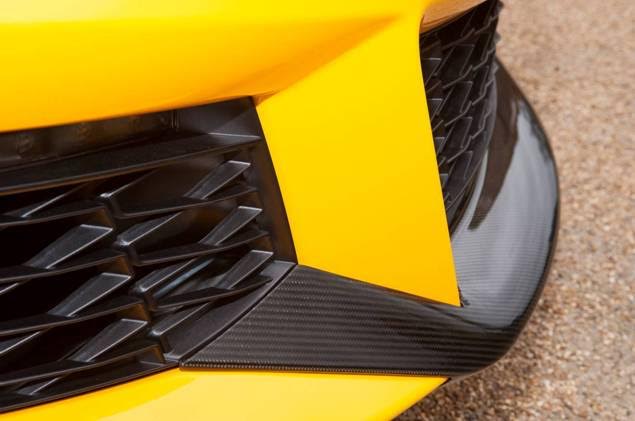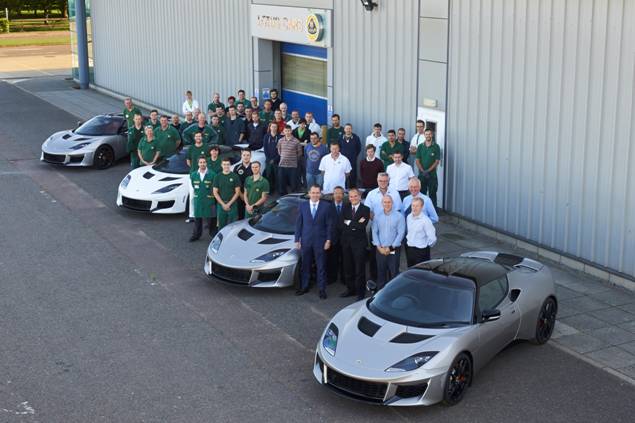Russell Carr stops by Jay Leno’s Garage with a couple of Lotus Evora 400s
The New Lotus Evora GT410 Sport
Relentless in its development of world-class sports cars, Lotus has unveiled the new Evora GT410 Sport to complete the revised line-up of Hethel’s fastest model.
Launched in Lotus’ 70th year and ahead of its anniversary celebrations, the new Evora GT410 Sport takes one of Lotus’ success stories, and refines it through the application of enlightened design. Available in both 2 seat and 2+2 configurations, and in manual and automatic transmissions, the Evora GT410 Sport draws from the phenomenal Evora GT430 to provide advanced aerodynamics to an already celebrated sports car.
Combining the latest design philosophy with a car acclaimed by both critics and customers, it packs raw performance with Lotus’ latest aerodynamic developments, to provide a first-class replacement for the Evora Sport 410 model.
Employing key elements of the GT430’s sculptured body style, including specifically designed new composite front and rear body panels, but without some of the high downforce elements, the new Evora GT410 Sport enjoys a far subtler and sleeker silhouette. However, as with all Lotus sports cars, aerodynamic downforce is a requirement and this new GT-class coupe generates up to 96kg of downforce (50% more than the Evora Sport 410) making it the new benchmark when compared to similarly priced rivals.
The Evora GT410 Sport is powered by a specially calibrated and tuned higher-output version of Lotus’ supercharged, 3.5-litre 6-cylinder engine with integrated water-to-air charge cooler, producing 410 hp at 7000 rpm and 420 Nm of torque from 3500 rpm. It powers the GT410 Sport from 0-60 mph in just 3.9 seconds (automatic) and the manual version in 4.0 seconds.
The development of the new Evora GT410 Sport afforded Lotus the opportunity to optimise mass, resulting in an unladen weight of 1,297 kg and a lightest possible dry weight of 1,256 kg (including all the optional titanium exhaust, saving 10 kg, and the Lotus-tuned Öhlins TTX aluminium two-way adjustable dampers, saving 13 kg) – a total saving of 98 kg when compared to the Evora 400 benchmark, and up to 28 kg less than the already featherweight Evora Sport 410.
Launching the new Evora GT410 Sport, Jean-Marc Gales, CEO, Group Lotus plc said, “We are continually exploring new ideas, innovating and evolving our cars in pursuit of perfection. The new Evora GT410 Sport takes the lessons learnt from the development of the GT430 to deliver something outstanding and highly capable.”
Lotus Evora GT410 Sport in more detail
Lotus’ newly defined GT-class sports car captures the essence of the company’s headline model. The application of top-down evolution introduces the new front and rear aesthetic, first seen on the GT430. As a result, the car’s design combines considerable physical presence with natural aerodynamic ability.
The revised front panel features two enlarged carbon fibre ducts, with integrated air blades, to efficiently move air around the front wheels reducing turbulence and decreasing drag. Additional downforce is created by the combination of the deep front splitter and new motorsport-derived rear diffuser, mounted beneath the new style metal mesh grille which gives a cleaner finish. Sculptured carbon fibre ducts behind each rear wheel vent high pressure air as quickly as possible from the rear wheel arches, balancing downforce.
Cumulatively this all works to boost downforce to 96 kg at 190 mph, a sizable jump of 50% over the outgoing Evora Sport 410, and a massive three-times that of the Evora 400 with an improved drag coefficient. This elevates the Evora GT410 Sport to the top ranks of Lotus’ most aerodynamically efficient road cars.
As with all high-performance Evoras, carbon fibre plays a considerable role in the car’s construction. Standard carbon composite components include the front access panel, roof panel and a one-piece louvered tailgate with integrated spoiler, as well as the elements within the front air blade system and rear wheel exit ports.
This focus on the car’s critical mass delivers its headline power-to-weight ratio of 326 hp / tonne and the top speed to 190 mph (305 km/h).
Despite the car’s low mass, a range of lightweight options can be specified for the Evora GT410 Sport. This includes a titanium exhaust, cutting 10 kg from beyond the car’s rear axle.
Making the most of the traction on tap, the Evora GT410 Sport uses Michelin Pilot Sport Cup 2 tyres (235/35 R19 at the front and 285/30 R20 at the rear) with a sports suspension package of Eibach ultra-light, low-sideload springs and Bilstein sports dampers – all fitted as standard.
A touring suspension package is available as a no cost option, featuring Bilstein® non-adjustable dampers, with touring specification, and Michelin Pilot Sport 4S tyres.
For full damper adjustability, a race suspension package using Lotus-tuned lightweight Öhlins TTX aluminium two-way adjustable dampers (twenty click adjustment compression and rebound) which save 13 kg, can be specified to tune the Evora GT410 Sport to precisely suit particular road or track conditions.
Reducing un-sprung mass, ultra-lightweight, fully machined, forged aluminium wheels (19″ 8J front and 20″ 9.5J rear 10 spoke alloy wheels) are available in either silver or matt black. The option of upgrading to one inch wider (10.5J) rear wheels as used on the Evora GT430, is available and stopping power comes courtesy of AP Racing four-piston calipers front and rear with lightweight 2-piece cross-drilled and ventilated brake discs (front 370mm x 32mm, rear 350mm x 32mm).
In addition to Lotus’ slick, six-speed manual gearbox with a Torsen type limited slip differential (LSD), the Evora GT410 Sport is also available with an automatic transmission option. Slightly quicker through the gears, with a 0-60 mph time of 3.9 seconds, the six-speed automatic transmission utilises an optimised gearbox ECU for ultra-fast changes. Gear selection is made via lightweight aluminium paddles mounted to the steering wheel.
The new Evora GT410 Sport features four driver selectable ESP modes – selected via a dashboard switch. ‘Drive’, ‘Sport’, ‘Race’ and ‘Off’. Sport and Race settings increase throttle response, respectively increasing traction slip – allowing the driver a finer degree of control before intervention.
As with its Evora stablemates the Evora GT410 Sport cabin includes Lotus’ beautifully detailed carbon race seats (2+0 configuration only) and carbon door sill inserts. The steering wheel, dashboard, door panels, transmission tunnel, centre console and instrument binnacle are all trimmed in black Alcantara®, complemented by contrast twin colour stitching. Optional Sparco race seats are available in both 2+0 and 2+2 configurations with the latter requiring either the optional wider 10.5J rear wheel option, as featured on the Evora GT430, or the lightweight forged wheel option from the Evora 400, which benefits from a 9.5J rear wheel size. An integrated 7” touch-screen infotainment system with AppleCarPlay and Android Auto, Bluetooth® functionality, satellite navigation and reversing camera can also be specified.
Jean-Marc Gales concluded, “Starting 2018 in style, the Evora GT410 Sport is just the beginning of an incredibly strong year for Lotus. The core principles of Lotus and our founder Colin Chapman remain paramount as we work on the next generation of vehicles whilst building our best sports cars yet.”
Every new Lotus Evora GT410 Sport can be personalised through the increasingly popular Lotus Exclusive programme. Developed by the Lotus Design team to inspire customers, it combines traditional British craftsmanship with the best of modern design, and allows owners to tailor vehicles to their personal taste. Since its introduction last year, roughly a third of all new Lotus cars now undergo some form of customisation.
The new, fully homologated Lotus Evora GT410 Sport range can be ordered now in European and Asia Pacific markets, following in summer 2018 for the USA and China.
Test drive an Evora 400
To celebrate the launch of the world renowned Lotus Evora Sport 410 and the critically acclaimed Evora 400 in North America, Lotus Cars is pleased to announce the Lotus Cars USA Dealer Tour.
Throughout April and May, you’ll have the unique opportunity to experience a Lotus from the best possible position, the driving seat.
Taking place across the country, our Dealer Tour not only includes an unprecedented level of access to Lotus Cars, but also a number of activities* unique to each Dealer Partner including (but not limited to):
- Evora test drives, demonstrations and track events.
- Pre-owned Lotus cars inventory.
- Exclusive Dealer Tour Offers.
- Refreshments and entertainment for all the family.
*Please contact your local dealer for details of event activities.
Lotus Dealer Tour – coming to a town near you:
Lotus of Las Vegas – April 21st and 22nd
Lotus Motorcars of Long Island, NY – April 21st and 22nd
Lotus Chicago – April 27th and 28th
Auto Europe, Detroit, MI – April 28th and 29th
Lotus Nashville – May 5th and 6th
Star Motor Cars, Houston, TX – May 5th and 6th
Lotus of Atlanta – May 12th and 13th
Lotus of Indianapolis – May 12th and 13th
Lotus of Miami – May 12th and 13th
Park Place Limited, Seattle, WA – May 12th and 13th
Believe the hype – you’ve tried the rest, now try the best.
Reserve your place today.
Lotus Evora 400 first drive
Last week Tom Sutton from Boardwalk Lotus invited the GGLC to swing by and take a look at the new Evora 400 which will be begining US deliveries later this summer. This particular car was one of two euro-spec demo cars that have been going all over the US to attend the auto show circuit and had 21000 kms on it. I got the chance to drive it for a few miles and wanted to write up my thoughts on the car. These are all my personal opinions and will be coloured by my experiences from owning an Elise for 10 years and an Evora S IPS for ~8 months.
Exterior
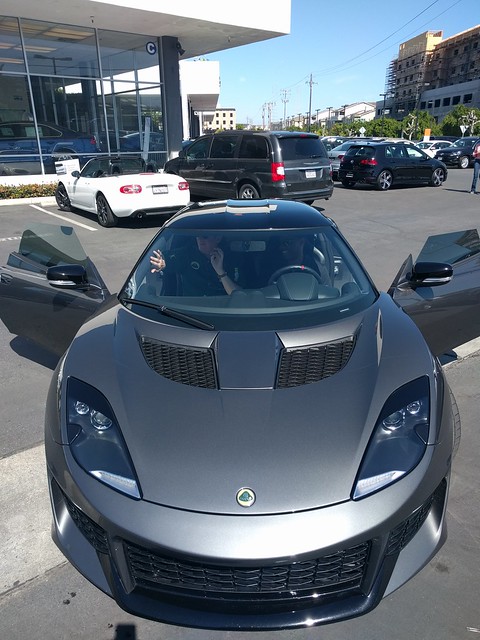
When the Evora 400 was first announced I have to say that I was not a big fan of the looks. The sharp lines on the new front and rear looked a little “boy racer” to me and pushed me into getting an Evora S instead of waiting for the 400. However seeing the car in the flesh I have to say that the new front end looks much better in person and works really well in this carbon grey colour. The black line above the splitter kind of merges into the body and removes the thing I found most annoying about the front. The plastic grill replacing the mesh looks quite good as well.

The rear also looks much better in person and I’d have to say that the Evora 400 looks very modern and contemporary.
Ingress/Egress

This is perhaps the single greatest improvement of the 400 over the first gen Evora. The side sills are a lot lower and narrower than those of the Evora S (below) which means it is as easy to get in and out of as a regular sports car – no lotus position needed. Additionally the speaker enclosure in the door has been made smaller and thinner which means your feet don’t hit the door every time you get out (even with size 14 shoes). This has been my biggest annoyance with the Evora as a daily driver as you have be even more careful with your feet getting out that you have to in the Elise.
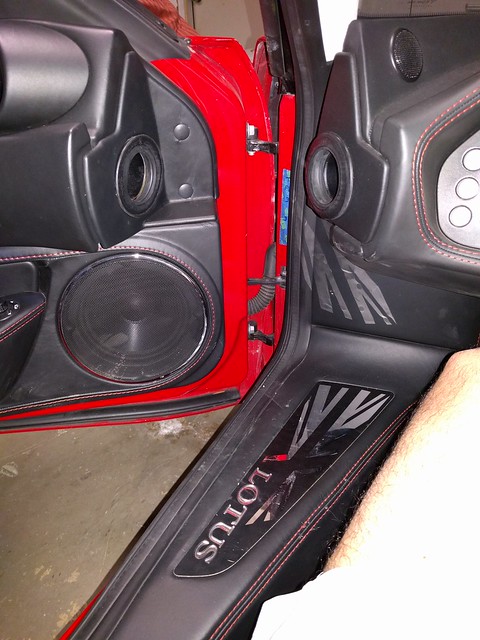
Interior
The first thing you notice about the interior is the extra legroom in the drivers seat. The narrow sill appears to have continued towards the wheel well to give your left leg more room. The manual cars now finally have a dead pedal where you can rest your foot and if feels like there is more footroom in general which came in handy for my size 14 feet. That said my Evora S is an IPS so its hard for me to compare against the manual 400. It also felt like my right knee had some more room though the console didnt appear to be much narrower.

The next thing you notice is the easy access and visibility of all the switchgear. You no longer have to cock your head and look behind the steering to squint at the controls. Plus they are now black with white lettering which makes them significantly easier to read than the old chrome buttons. The digital parts of the dash are now white on black and people who have been driving the car for extended periods tell me that they are easier to read that the red displays on gen 1. The steering wheel material has changed and feels more “rubbery” than my S – this is one change I would love to make to my car if possible. The side mirror controls have been moved to the dash for easy access while the trunk and fuel buttons have been moved to the door. Extra points for the trunk button no longer requiring the impossible combination of key in ignition, car in park, ebrake on, full moon night, fifth wednesday of the month, etc… to work 🙂
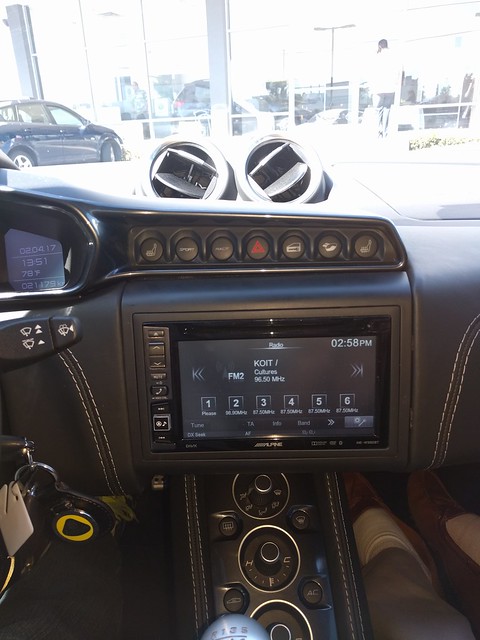
The other thing I really liked was the HVAC controls are easier to turn and have many more detents instead of the current half dozen or so. The stereo is also different but I did not get a chance to play around with it. The glove box is now manual instead of electric which aligns with simplify and add lightness.
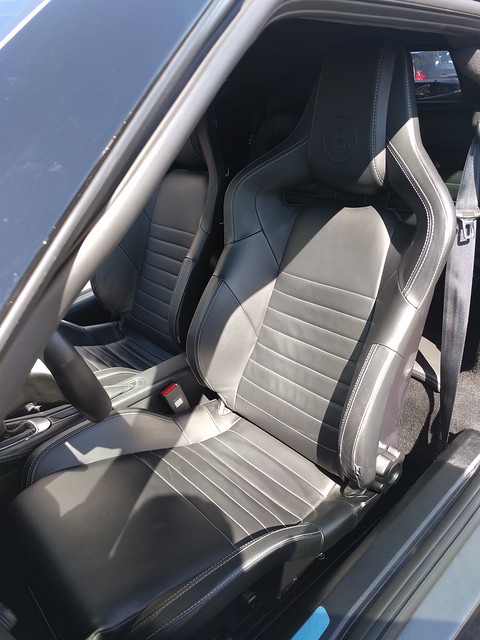
The seats have switched from Recaro to Sparco and now have side airbag included. The stitching is a little different but they are just as comfortable as the original car. They now have a little leather pull to flip the seats forward which is much easier to reach and IMHO looks a lot cooler. The rear seats are as vestigial as ever.

Driving impressions
I only got to drive the car for a few miles in traffic but the ride and handling felt the same as the S. It felt fast but with the lmited opportunities to accelerate it did not feel that much faster than my S. The thing I really liked about the drive was the exhaust which is sportier (louder with better tone) and has a button that controls the noise level independent of the ECU mode. This means you can drive the car in sport mode with the quiet exhaust or be in regular mode with the loud exhaust – the S ties the louder exhaust to the sport mode only which can get a little annoying in city driving. The shifter is also really smooth and felt a better than the other Evoras I have driven and miles ahead of the Elise.
The other thing I liked is that the Evora 400 is better built than the Elise and does not have all the rattles and squeaks you have come to expect from a Lotus. The demo car had over 13k miles on it and felt like a quality item just like my S does after 2 years and ~15k miles.
Final Thoughts
My biggest takeaway about the Evora 400 is that it is a much more useable car than the S. It retains the excellent driving dynamics of the original car and adds a nice boost in power while making it easier to live with on a day to day basis. People considering a Porsche 911 as a daily driver should really have a look at the Evora 400 – it is now a competitor in terms of usability as well as performance. For me personally while it is a lot more car I can’t justify the premium over my existing S. That said the upcoming 400 convertible might make me change my mind 😉
Lightening strikes again: The Lotus Evora Sport 410
In a move that should surprise no one, Lotus has raised the bar once again by lightening the Evora in order to develop the sensational Evora Sport 410.
Following on from the recently announced Elise Cup 250, and the Exige Sport 350, Lotus’ famous Lightweight Laboratory has been hard at work cutting the weight of the Evora 400 by a massive 70kg. With a host of high-performance carbon fibre components as standard, and sharing the 410 hp supercharged engine with the track-bred 3-Eleven, the Lotus Evora Sport 410 clocks 0-60 in 3.9 seconds on its way to a top speed of 186mph.
Jean-Marc Gales, CEO of Group Lotus plc, commented, “We couldn’t help ourselves, and many may have guessed what we were planning following our recent announcements. We wanted to make the Evora even better: lighter, faster and sharper, but our team has exceeded our expectations. Lotus has distilled what makes the Evora so special into something that’s even more focused. The result is dynamically excellent and nothing short of superb.”
This new, top-of-the-range Evora has been thoroughly re-evaluated, with every component assessed, optimised and reengineered as required. This covers every aspect of the car, including a drastically simplified carbon fibre tailgate (combining five separate elements into one), new lighter-weight door trim panels and the liberal addition of carbon fibre across the entire car.
The Sport 410 builds on the excellent work undertaken in the development of the Evora 400, itself a massive enhancement over the first generation of Evora. However, far from a stripped-out special, the Evora Sport 410 retains excellent road manners, being refined and composed during everyday driving.
The significant drop in mass, and a power boost, means the Evora Sport 410 is capable of lapping the company’s Hethel test track in 1 minute 28 seconds* – an impressive 3 seconds faster than the Evora 400. Reflecting what Lotus does best, it demonstrates the company’s principle of ‘adding lightness’.
The Lotus Evora Sport 410 is the result of Lotus’ philosophy of continuous improvement. With a lower centre of gravity, and a kerb weight slashed to just 1,325 kg, the car provides an impressive 309 hp/tonne.
In addition to boosting straight-line speed, the significant reduction in mass has allowed sharper, more agile and intuitive handling – with even greater accuracy and feel. Jean-Marc Gales added, “The Evora chassis was already the best in the business – the Evora Sport 410 takes it to a whole new level”.
Complementing this is a higher-output version of the supercharged, 3.5-litre 6-cylinder engine, developed through the Lotus 3-Eleven project which has beaten Nürburgring records. As a result, the car boasts 410 hp at 7000 rpm and 410 Nm of torque at 3500 rpm.
The high-performance, carbon fibre components have played the single biggest role in the evolution of the Evora Sport 410. These include front splitter, roof panel, tailgate, and rear diffuser as well as race-derived sports seats and a revised front access panel. The one-piece carbon tailgate incorporates a louvered section, inspired by some of Lotus’ most-famous heritage models, and together with carbon rear quarter-light panels help provide the car with a sleeker, fastback-style trailing roofline. These changes have also improved the car’s aerodynamic downforce by 15% with no increase in drag.
The car’s reduced kerb weight has allowed the recalibration of the suspension, with improved geometry and completely revised damping, as well as a ride height 5mm lower than the Evora 400. As a result, handling is sharper, along with better body and roll control, yet ride comfort and composure is retained. Ultra light-weight, 10-spoke forged aluminium wheels, and optional Michelin Cup 2 tyres, complete the car’s dynamic revisions.
Appealing to purists, the Evora Sport 410’s manual gearbox features a low inertia flywheel, to help ensure swift changes, while a Torsen-type limited slip differential (LSD) gives better traction, and faster exit speeds when cornering. Available as an option, the automatic transmission offers gear selection via lightweight aluminium paddles mounted to the steering wheel.
The new Evora Sport 410 also features Lotus’ Dynamic Performance Management (DPM) which, selected via a dashboard switch, provides ‘Sport’ and ‘Race’ settings. Proportionally increasing throttle response, lowering traction slip thresholds and removing understeer recognition, it allows enhanced control before the system intervenes.
As standard, the Evora Sport 410 comes with carbon fibre sports seats trimmed with Alcantara®, along with the steering wheel and centre console. An integrated touch-screen entertainment system can also be specified, including iPod® connectivity and Bluetooth® functionality.
The rest of the Sport 410’s cabin has received attention as part of its development. Weight saving measures includes attractive one-piece door trim panels finished in Alcantara®, with contrast stitching, the deletion of door arm rests and stowage pockets, the relocation of tailgate and fuel filler release buttons and the removal of speakers – if an entertainment system is not specified.
As well as the standard paint selection, the new Evora can also be personalised through the recently launched Lotus Exclusive programme. Combining traditional British craftsmanship with modern design, the service inspires customers to spend time tailoring the character of their Lotus with a comprehensive array of options.
The Lotus Evora Sport 410 will be limited to a global production run of one-hundred and fifty vehicles per year and will be available in all major markets from June 2016.
A specific North American version of the Evora Sport 410 will be announced later in 2016.
Those wishing to register their interest in the new Lotus Evora Sport 410 should visit: www.lotuscars.com/lotus-evora-range
The first Lotus Evora 400 sports cars leave Lotus’ Hethel headquarters, on the way to dealerships
The first Evora 400 sports cars destined for customers and dealers have driven off the assembly line and are soon to arrive at dealerships across the UK and mainland Europe. The significant occasion was marked by a small celebration with proud members of the engineering and manufacturing team at Lotus, who are responsible for hand-building Lotus’ fastest production car to date.
Jean-Marc Gales, CEO, Group Lotus plc states, “The Evora 400 has already received admiration and critical acclaim from media around the world, praising its performance, handling and design. In September and October, Lotus dealers throughout the UK and mainland Europe will be receiving their demonstrator and customers cars, so now is the opportunity for drivers to get behind the wheel and experience the Evora 400 for themselves.”
Over two thirds of the Lotus Evora 400 is new, including its supercharged and charge-cooled mid-mounted 3.5-litre V6 engine which produces 400 hp and 410 Nm of torque. Such revisions result in a faster and dynamically more capable model than the previous Evora and are the reason the new Evora 400 has become the most eagerly anticipated Lotus model for several years.
Weighing just 1395 kg, (42 kg lighter than the previous Lotus Evora S) the new Evora 400 combines high performance with the legendary Lotus benchmark handling. This performance, and handling, combined with a maximum speed of 186 mph (300 km/h) and acceleration 0-60 mph in just 4.1 seconds (0-100 km/h in 4.2 seconds), enables the new Lotus Evora 400 to lap the Lotus test track at Hethel seven seconds faster than the previous Evora S in a time of 1 minute 31 seconds.
The Lotus Evora 400 benefits from a high level of standard specification including 370 mm composite two piece brake discs from AP Racing, a Limited Slip Differential, automatic air-conditioning and infotainment system including satellite navigation. In addition to this, the options list includes automatic transmission, cruise control, Alcantara or Leather trim upgrades and metallic paint.
A “Black Pack” option provides a distinctive look, with selected exterior panels including the roof, sills and centre section of the three-element rear wing in gloss black and a dark headlining in the interior. Lightweight forged alloy wheels can be specified along with optional yellow or black brake callipers.
Over the last 15 months, Lotus has increased its number of dealers worldwide from 138 to 193.
North American markets and China will receive the Evora 400 as a 2017 model year in early 2016.
Drivers who are interested in test driving the new Lotus 400 are encouraged to contact their nearest Lotus dealer or to visit http://www.lotuscars.com/testdrive
Lotus Evora 400 International pricing including local taxes where applicable:
UK (Pound Sterling) – £72,000
Germany (Euros) – €96,000
Japan (Yen) – ¥13,200,000
USA (Dollars) – $89,900 (excluding local sales taxes)
China (RMB) – 1,318,000
First Lotus Evora 400 drives off the assembly line at Hethel
In a small celebration with a selection of senior management, manufacturing and engineering staff, the first new Lotus Evora 400 has driven off the assembly line at Hethel.

Jean-Marc Gales, Chief Executive Officer of Group Lotus plc, says, “Today is a very significant stage in our long term plan, which we set-out more than a year ago. With the first Evora 400 coming off the line, we have achieved a key milestone for Lotus.”
Jean-Marc Gales continues, “None of this would be possible, of course, without the confidence and commitment of our workforce who, with great skill and talent, hand build every Lotus car at Hethel.”
The new Lotus Evora 400 laps the Lotus test track at Hethel six seconds faster than the previous Evora S in a time of 1 minute 32 seconds. Combining high performance with the legendary Lotus benchmark handling, it is faster and dynamically more capable than the previous Lotus Evora leading to greater agility and a more involving drive.
Maximum speed is 186 mph (300 km/h) and acceleration 0-60 mph is just 4.1 seconds (0-100 km/h in 4.2 seconds). Over two thirds of the Lotus Evora 400 is new, including its supercharged and charge-cooled mid-mounted 3.5-litre V6 engine producing 400 horsepower and 410 Nm of torque. A new aluminium chassis incorporates a new interior and the lightweight composite body has changed significantly both front and rear.
The new Evora 400, which was revealed at the Geneva Motor Show in March, will enter production for European markets in the summer and deliveries will commence in August this year. China and North American markets will receive the Evora 400 as a 2017 model year in early 2016.
The first Lotus Evora 400, finished in metallic black is destined to be a promotion car for Lotus.
Lotus Evora 400 International pricing including local taxes where applicable:
UK (Pound Sterling) – £72,000
Germany (Euros) – €96,000
Japan (Yen) – ¥13,200,000
USA (Dollars) – $89,900 (excluding local sales taxes)
China (RMB) – 1,318,000
Official fuel consumption figures and CO2 emissions figures are not available at the time of going to press. They will be provided on the Lotus website www.lotuscars.com as soon as they are available.
